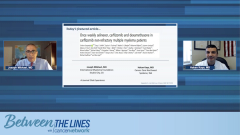
Selinexor: Clinical Pearls for Current and Future Use in R/R MM
Dr Joseph Mikhael and Dr Hakan Kaya provide advice for community oncologists who use selinexor and discuss the future of selinexor in patients with R/R MM.
Episodes in this series

Joseph Mikhael, MD: Before we close off, I thought it'd be good for us to wrap up and think what are those key pearls? You work so diligently in the clinic. I know you have an academic and a community position. You're a busy, busy clinician and we have a lot of busy clinicians listening in today who want to just gimme the facts. What are the clinical pearls? How am I going to use this drug? What key points would you want to highlight to them?
Hakan Kaya, MD: I can tell what I tell my patient. I see a patient who's a candidate for selinexor-based regimen. I tell them that, please let us know if you get any side effects so we can manage that. I think that's the key point, informing the patient so that they can call you and they can manage the side effects. Be very aggressive about symptom management or prevention of the symptoms. Then dose reaction is key. I think that pretty much summarize. Things will get better in a month.
Joseph Mikhael, MD: That's right. Critical. Worst month is the first month. Prevent the nausea with two anti-nauseants, educate patients and your staff about what to do because I do think we're going to see more selinexor in multiple myeloma. I think we're going to see it come earlier in the disease course. I think people are going to be using it in multiple different combinations. Obviously, we've highlighted today the carfilzomib combination, but as part of that STOMP trial, it was being looked at in other combinations as well. I do think this notion of introducing a new mechanism of action early on becomes really important so that we can give our patients the best outcomes as early as possible in the relapse course. Well, thank you very much. I'm sorry. Please go ahead.
Hakan Kaya, MD: I'm sorry to interrupt. This study just highlighted what you just said. When it was used earlier on the patients after only one or two lines of therapy, response was better, duration response was much better, PFS was much better, so I think hopefully in the future we'll start using this regimen earlier. As you know, for many, many years the induction chemotherapy for myeloma was RVD, but later on now, we've been using their Dara-RVD so for patients who relapsed after their RVD, this will be an excellent regimen. That'll be only one or two lines of therapy. I think they will have a much better and longer response to carfilzomib-selinexor combination.
Joseph Mikhael, MD: I completely agree with you. I think as we move towards quadruplets and more exposure to classes earlier on, we do wanna include this fourth class of an XPO1 inhibitor. Well, this has been a great discussion, my friend. I think we've reviewed this paper in a way that helps not only the academic thinking behind it but indeed the community practice behind it. Thank you very much for your time. I really appreciate spending some time with you. For our listeners, thank you for chiming in today and listening to this. We trust it's going to be helpful as you care for your patience.
Hakan Kaya, MD: Thank you.
Newsletter
Stay up to date on recent advances in the multidisciplinary approach to cancer.



















































































